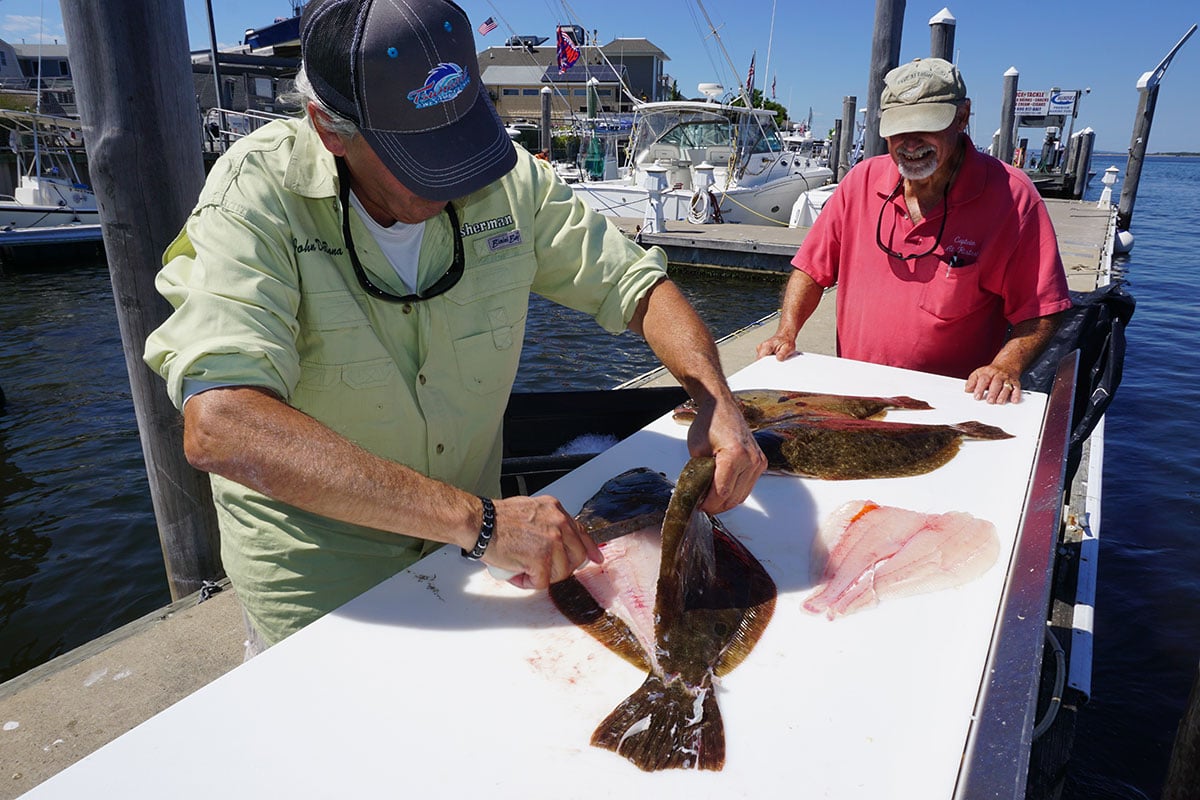
As all anglers know, one knife, and one knife only, simply won’t cut it!
I’ve talked to a lot of captains and mates over the years, have taken folks out on hundreds of successful charters, and cut up thousands of fish, learning a few things along the way. As I look over my current inventory of fishing knives, I have at least 35 kept on both of my Edgewater center consoles, in my home and away travel bags, and in a stash box at my house. Of this group 80% of them are either Dexter or Penn knives, with the remaining cutlery consisting of a variety of models from Rapala, Danco, Berkley and others.
So what types of knives do freshwater and coastal anglers need to have in their bag of tricks? I reached out to few industry friends to get their spin on it, while taking a closer look at blades in the world of fishing, and shellfishing.
For starters, a fillet knife is an oft-misunderstood term that erroneously includes some of the other knives on our full list of knives for fishermen, which also includes knives for boning, breaking, utility, bait and emergencies.
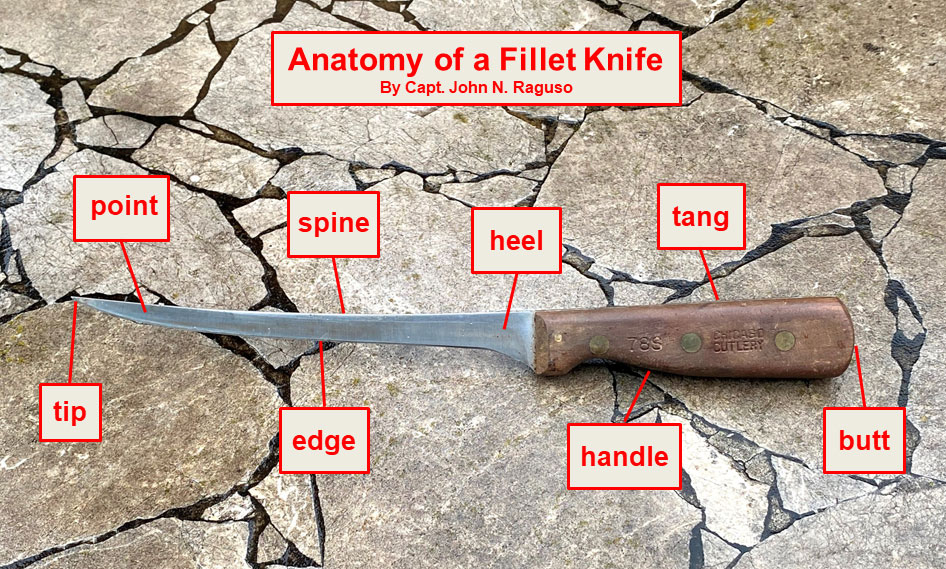
Flesh & Bone
A fillet knife, while similar to a boning knife, is typically equipped with a thinner and more flexible blade than the other types, ranging in size from 6 to 9 inches in length. Due to the flexibility of the blade, you can easily contour the knife to cut close to the skeleton or backbone of your catch to get maximum yield from the meat. The extra-narrow shape and reduced profile allows the user to control the knife with more ease. On the downside, the lighter weight and reduced profile of many fillet knives have a tendency to “wobble” in your hands, especially if you don’t have a good grip or if the handle is wet or slimy. Some fillet knives offer a stiffer flex with a deeper blade, while others offer a longer blade with a reduced profile. There are many choices for this type of tool, so find one that works best for you.
I spoke with Carl Abissi from Dexter Outdoors who said “7-inch and 8-inch fillet knives are the most common sizes and are perfect for most fish that east coast anglers bring to boatside and want to harvest,” while also adding “If you spend most of your time and effort going after bottom fish like sea bass and porgies, a smaller 6-inch flexible fillet knife will be easier to navigate in the downsized profiles of these fish.”
“If you are a big fluke fisherman and prefer to cut the entire front or back side of these flatfish in one piece, longer 8- to 9-inch flexible fillet knives will probably operate with the most efficiency and ease,” Abissi noted, going on to explain that if larger, thick-skinned fish like big tuna or sharks are on the menu, the 9- to 10-inch fillet and scalloped edge knives will give you the length and power you will need to get the job done. “If you had to choose just one knife for most of your applications, it’s hard to go wrong with a 7-inch fillet knife that will work great with a variety of inshore fish ranging from stripers to black sea bass,” Abissi added.
A boning knife is usually in the 6- to 7-inch range with a slight upward curve that affords the operator a better view of what is being cut when taking meat off the bone. The curved blade has more cutting surface than a straight-edged fillet knife, so more meat can be taken off the skeleton with less effort, which really adds up when you are slicing up dozens of fish. Because of its slightly stiffer and deeper blade, a boning knife has less of a tendency to wobble in your hand when making your cuts. Many times boning knives with the right size and flex are used as fillet knives.
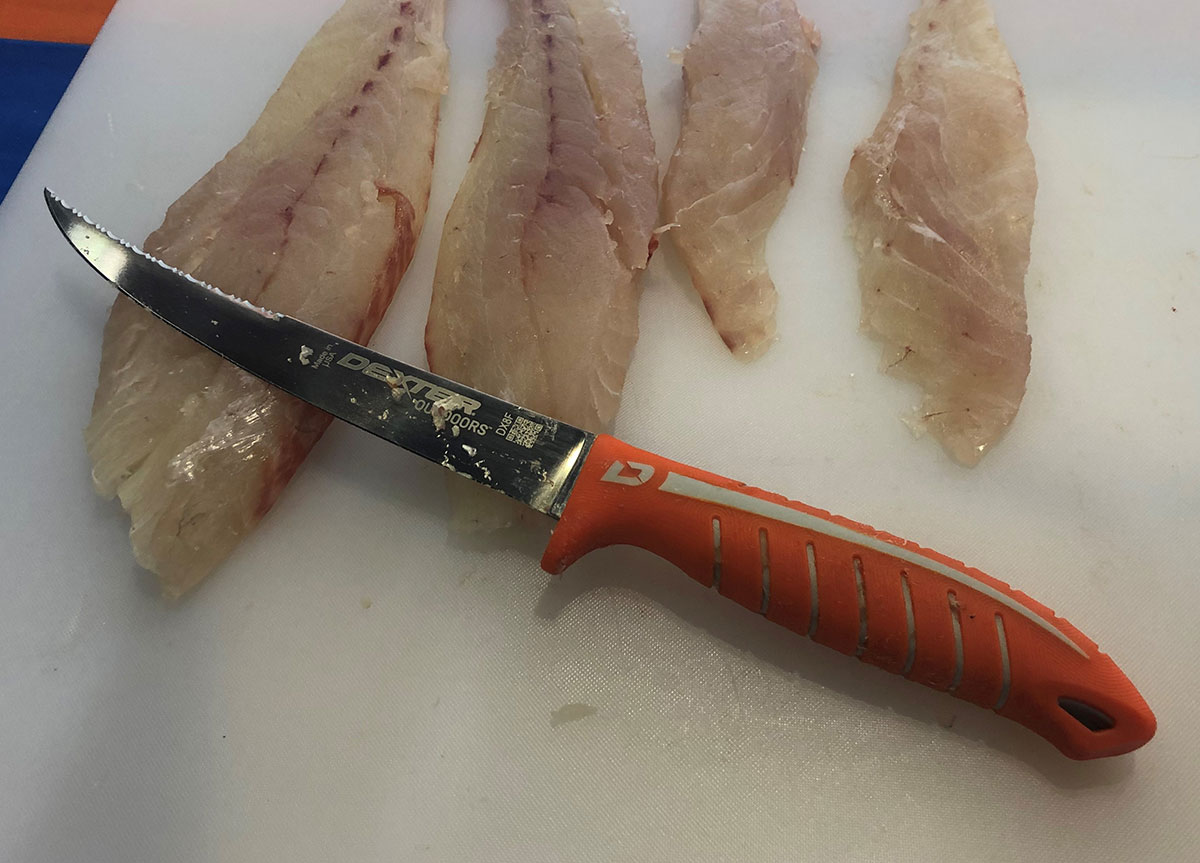
Cut Bait In Emergency
The blades on a breaking knife typically range from 8 to 10 inches in length. Breaking knives are usually thinner and more flexible than stiff serrated utility knives of the same size, with tips that curve upwards towards the spine of the blade. Compared to a fillet or boning knife, breaking knives have thinker, deeper bodies with more backbone, and are best when dealing with large, whole, big-bodied fish like tuna, shark, halibut or swordfish.
Like the name implies, a utility knife can take on many shapes and sizes. For the fishing boat application, I will define a utility knife as one that has a stiff, deep, serrated edge with substantial backbone that fulfills a variety of tasks, from cutting an anchor line, chopping up frozen baits, to taking the bony tail off a big tuna or shark. I have a 9-inch Dexter Sani-Safe knife that I have used for the better part of two decades and it is still going strong with no signs of slowing down.
It makes sense that you are not going to sacrifice the edge that you painstakingly put on that favorite fillet knife for cutting up squid strips or dicing a clam into bite sized pieces. Hence many anglers adopt the dedicated bait knife option that you can typically acquire for less than $10 at your local tackle store or online. After rusting out a bunch of old stainless steel serrated steak knives cutting up squid, mackerel and clam baits, I finally broke down and purchased a 3-1/2-inch Dexter Sani-Safe net-twine-line knife and repurposed it as my everyday bait knife. It has lasted a few seasons cutting up a variety of oily, salty baits with its sharp serrated edge, and it’s stiff enough to slice through bone when chopping up bunker or mackerel.
See the description of my bait knife, which also serves as my emergency knife. Of course, you might consider the alternative of purchasing a special purpose knife like the Dexter Sani-Safe 3.5-inch Utility Knife. The standard plastic sheath allows the owner to wear it safely on a belt so it’s always ready for immediate deployment in case of an emergency. Trouble is, most recreational anglers don’t wear a knife on their belts. This observation is supported by some market research that the folks from Dexter did a few years back where they surveyed approximately 2,000 coastal anglers and discovered that less than 2% of the respondents actually wore a knife on their belts; pliers and clippers yes, knives no.
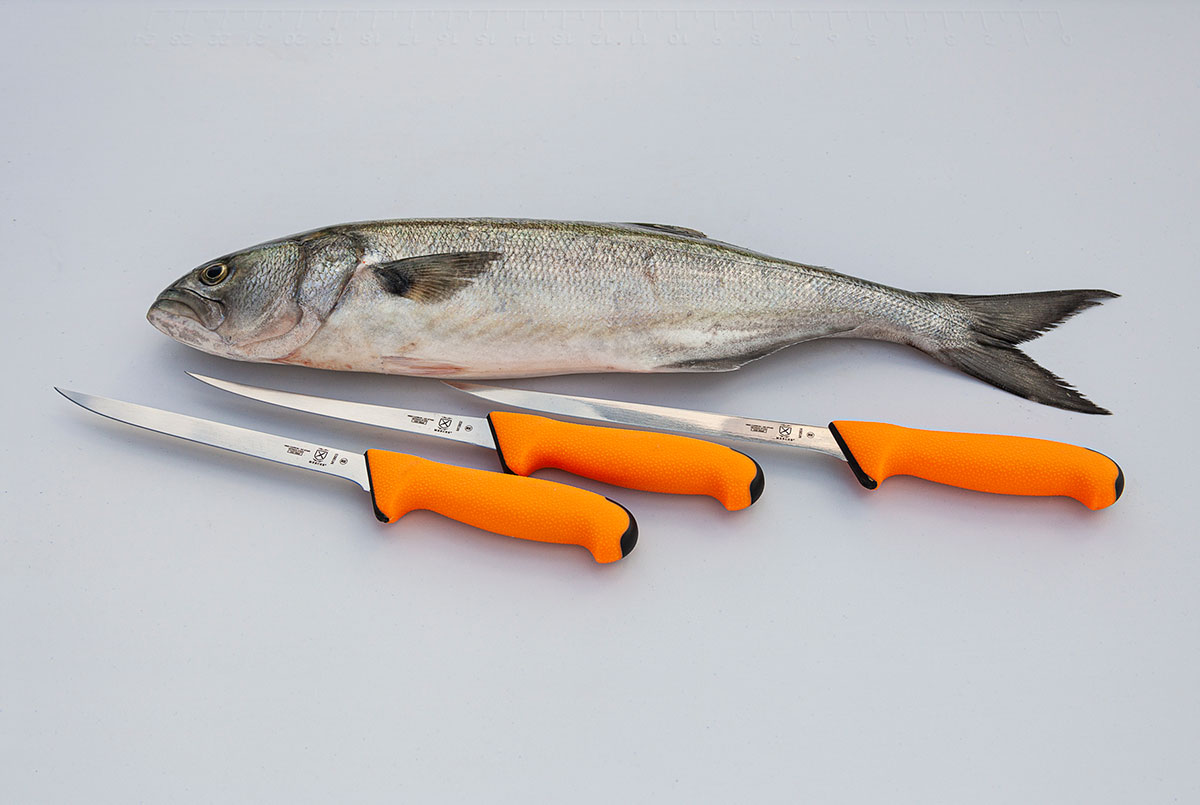
It’s All In The Steel
The ability of a fillet knife or any of its siblings like breaking or boning knives to hold a durable edge for an extended slicing and dicing session with your catch of the day rests in the quality of the steel. That same steel will determine how easily you can restore that sharp edge when the initial hone has been lost due to the knife’s interaction with scales, skin, flesh and bone. Dexter has long been one of the biggest names in both commercial and sportfishing circles, as well as in the culinary world, and the fact that the majority of professional captains, mates and seafood processors that I’ve come across prefer Dexter knives speaks volumes to their quality, variety of products and well-deserved reputation. “Dexter has been around since 1818 and in those 206 years we have learned how to produce the best steel alloys that can both hold an edge and also stand up to continued use over the long haul, especially in the saltwater environment,” Abissi said, adding “Since all of the knives in the Dexter Outdoors lineup are made in the USA, it makes sense that we use USA-manufactured steel in our cutlery.”
“The proprietary Dexsteel used in our Dextreme line and the other steel alloys used in our Dexter Outdoors products is made in Ohio and is a special alloy blend of high-carbon and stain-free steel,” said Abissi, adding “For our classic ‘old school’ wood-handled fillet knives, the steel formula is slightly different and has a higher percentage of carbon steel that requires the owner to clean and oil it on occasion to keep it looking good.” Abissi said these types of knives are preferred by many of the old-timers because of the feel of the handle, the flex and length of the blade, and the ability of the knife to be honed to an extremely sharp edge.
Since I’ve also been using Penn fillet and utility knives on my boat for the last few seasons, I reached out to their spokesperson Michelle Gandola about the type of steel used in their construction. “Penn prioritizes three crucial characteristics in their fillet knives, sharpness, edge retention and saltwater durability,” Gandola said, adding “Balancing these attributes is often challenging, as achieving an ultra-sharp edge can compromise durability and flexibility.” Gandola said Penn knives are made from German stainless steel, known for durability and corrosion resistance, with a black Nickel Titanium exterior finish. This unique alloy not only enhances flexibility and metal memory, but also boosts corrosion resistance, ensuring that the blade maintains its sharpness and shape even in harsh saltwater conditions.
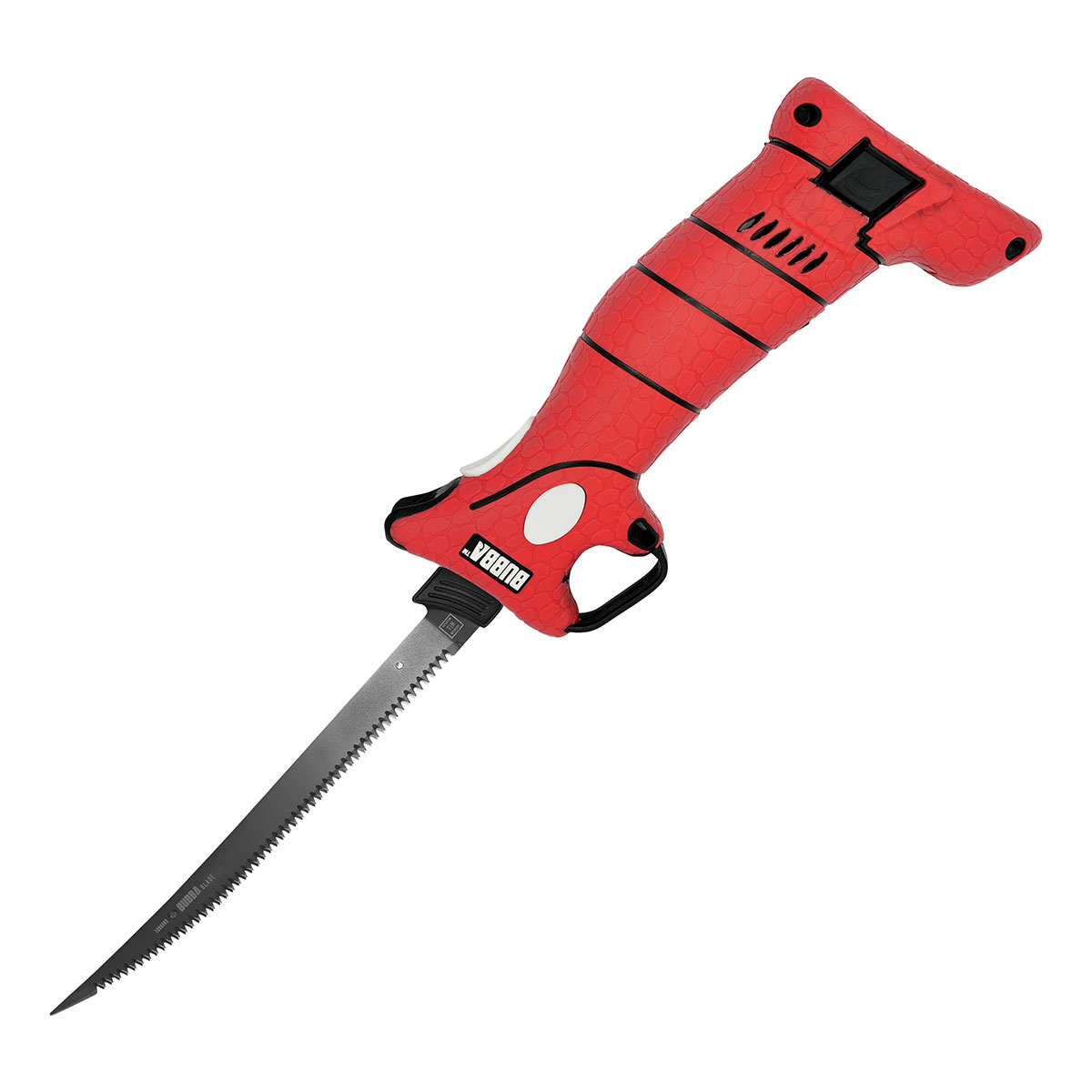
“The sharpening angle is one of the critical factors influencing the balance between sharpness and durability,” Gandola said, explaining how Penn’s fillet knives are sharpened at a precise angle of 26 degrees, striking the perfect balance between sharpness and resilience. “This angle ensures a keenly-sharp edge while maintaining durability, making Penn’s fillet knives ideal for the task of filleting a cooler full of fish,” Gandola said, noting how ongoing maintenance should include regular sharpening on a wet stone, ensuring optimal performance throughout their lifespan. “Periodic cleaning to rid the knives of saltwater residue is advised to prolong their durability and performance” she added.
| ON THE HALF-SHELL |
| If you’re looking to break into crustaceans that you like to eat, cooked or raw, you will want a dedicated shellfish knife or two for prepping. Local favorites like clams, oysters, mussels or scallops really require knives engineered for each one of these to pop open the shell with a minimum of fuss. “I typically keep a Dexter 3-inch blade, poly handle clam knife on the boat and/or in my travel bag for away charters, which allows me to make short work of various sized clams and mussels if we are using fresh ones for bait,” the author said, adding “These are relatively inexpensive; I bought one a few years back for less than $10 and it’s still working great with its specialized stiff carbon steel blade, tapered rounded tip and sharp edge.”
Take a look at Toadfish products as well, offering well-designed, species-specific tools like the Toadfish 2.75’’ Clam Knife, or Put ‘Em Back Oyster Knife which also “puts back” some of the proceeds to oyster replanting programs along the coast. There’s also the Toadfish Coastal Kitchen Collection which includes their patent/patent pending Oyster Knife, Crab Cutter and Rockmore Shrimp Cleaner which peels and devein in one single smooth motion. |
One of the new entries into the world of fishing knives is Mercer Sport. Although they have been a regular supplier of quality cutlery in culinary circles for the past 40 years, they recently got into sportfishing knives at last year’s 2023 ICAST tackle show. “All Mercer Sport fishing knives are crafted from high-quality, high carbon, no-stain X50 steel that is made for us at a factory in Solingen, Germany,” said Mercer’s Shane Conrad, adding “This proprietary steel alloy is known for its long-lasting sharpness and is ice hardened for increased blade strength. The mirror finish gives it added durability plus makes for easy cut and release when filleting a fish.”
“From there we ship the steel to a factory in Taiwan that crafts and shapes our fillet and slicer knives, adding a neon orange Santoprene textured handle that offers a secure, non-slip grip that really stands out and is easy to find on your boat,” Conrad added.
As far as best practices to keep an edge on your fishing knives, we could probably dedicate an entire article to cover this topic; perhaps we will! Stay tuned.



